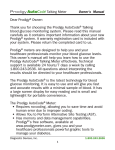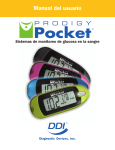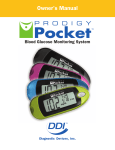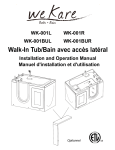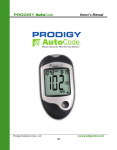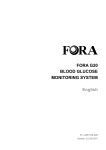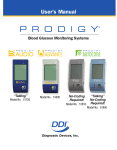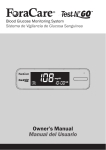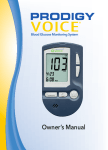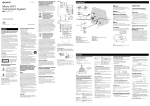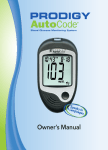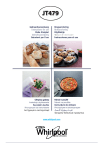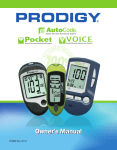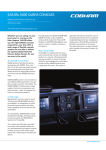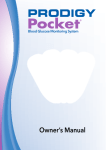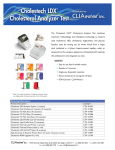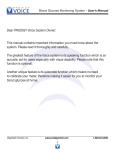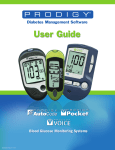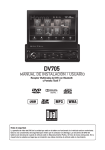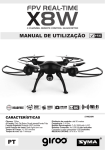Download Owner`s Manual - profit
Transcript
Owner’s Manual Blood Glucose Monitoring System AC Manual Rev. 2 09/09 ©2009 Diagnostic Devices, Inc. Prodigy AutoCode® is a registered trademark of DDI. All rights reserved. Prodigy Talking Meter Owner’s Manual Dear Prodigy® Owner: Thank you for choosing the Prodigy AutoCode® Talking blood glucose monitoring system. Please read this manual carefully as it contains important information about your new Prodigy® system. A warranty registration card is included with your system. Please return the completed card to us. Prodigy® meters are designed to help you and your healthcare professionals monitor your blood glucose levels. This owner’s manual will help you learn how to use the Prodigy AutoCode® Talking Meter effectively. Technical support is available 24 hours, 7 days a week by calling toll free 1.800.243.2636. All questions about interpreting the results should be directed to your healthcare professionals. The Prodigy AutoCode® is the latest technology for blood glucose monitoring. It is easy to use and will give you fast, accurate results with a minimal sample of blood. It has a large easy to read screen display and is small, lightweight for portable convenience. The Prodigy AutoCode® Meter: • Requires no-coding, allowing you to save time and avoid human error due to improper coding. • Allows you to perform Alternate Site Testing (AST). • Has memory and data management capabilities. Prodigy® meter’s free software gives you and your healthcare professionals powerful graphic tools to manage your diabetes. 1.800.243.2636 Prodigy Diabetes Care, LLC 1 Prodigy Talking Meter Owner’s Manual Table of Contents Important Safety Instructions........................................... 4 Important Health-Related Information............................... 5 About Alternate Site Testing (AST)................................... 6 Introduction to the Prodigy AutoCode® Meter.................... 8 Intended Use.................................................................. 8 Test Principle.................................................................. 8 Contents of the Prodigy AutoCode® Meter.......................... 9 Key Functions of the Meter............................................ 10 Setting up the Prodigy AutoCode® Meter......................... 11 Meter Display .............................................................. 11 Speaking Function......................................................... 12 Key Functions of the Test Strips..................................... 13 Important Test Strip Information.................................... 14 Set-Up Steps................................................................ 15 Control Solution Testing................................................. 19 About Prodigy® Control Solution...................................... 19 Important Control Solution Test Information.................... 20 Performing a Control Solution Test ................................ 21 www.prodigymeter.com Prodigy Diabetes Care, LLC 2 Prodigy Talking Meter Owner’s Manual Table of Contents Blood Glucose Testing.................................................... 24 Preparing the Lancing Device......................................... 24 Getting a Blood Sample................................................. 26 Performing a Blood Glucose Test................................... 28 Using the Meter Memory................................................ 30 Viewing Results on a Personal Computer........................ 32 Caring for your Prodigy AutoCode® Meter......................... 34 Maintenance................................................................. 34 Battery ........................................................................ 34 Battery Replacement..................................................... 35 System Troubleshooting................................................. 36 Special Messages......................................................... 36 Error Messages............................................................ 37 Troubleshooting Guide................................................... 38 Information about your Prodigy AutoCode® Meter............ 40 Comparing Meter and Laboratory Results....................... 40 Specifications................................................................ 42 Performance Characteristics.......................................... 43 Expected Test Results................................................... 44 Accuracy of Meter Measurements.................................. 45 1.800.243.2636 Prodigy Diabetes Care, LLC 3 Prodigy Talking Meter Owner’s Manual Important Safety Instructions Read this before using your Prodigy AutoCode® Meter. The following basic safety precautions should always be taken. •Close supervision is necessary when the device is used by, on, or near children, handicapped persons or invalids. •Use the device only for the intended use described in this manual. • Do not use test strips and control solutions that are not supplied by the manufacturer. • Do not use the device if it is not working properly, or if it has suffered any damage. • Before using any product to test your blood glucose, read all instructions thoroughly and practice the test. Do all quality control checks as directed and consult with a diabetes healthcare professional. Warning: Keep the test strip vial away from children; the vial cap and the test strips can be a potential choking hazard. Never chew or swallow a test strip. If this occurs, please seek medical assistance immediately. www.prodigymeter.com Prodigy Diabetes Care, LLC 4 Prodigy Talking Meter Owner’s Manual Important Health-Related Information Severe dehydration and excessive water loss may cause false low results. If you believe you are suffering from severe dehydration; consult a healthcare professional immediately. Elevated blood triglycerides, reducing substances such as uric acid and ascorbic acid at normal blood concentration, or acetaminophen, dopa, methyldopa, L-dopa and tolbutamide at normal blood concentrations should not significantly affect the results. Test results below 60 mg/dL (3.3 mmol/L) indicate low blood glucose (hypoglycemia). Test results greater than 240 mg/dL (13.3 mmol/L) indicate high blood glucose (hyperglycemia). If your results are below 60 mg/dL or above 240 mg/dL, repeat the test; if the test results are still below 60 mg/dL (3.3 mmol/L) or above 240 mg/dL (13.3 mmol/L), consult your healthcare professional immediately. Inaccurate results may occur in severely hypotensive individuals or patients in shock. Inaccurate low results may occur for individuals experiencing a hyperglycemic-hyperosmolar state. Please refer to your test strip package insert for additional important information. 1.800.243.2636 Prodigy Diabetes Care, LLC 5 Prodigy Talking Meter Owner’s Manual About Site Testing AboutAlternative Alternate Site Testing(AST) (AST) There are important limitations to AST. Please consult your healthcare professional before you perform AST. What is AST? Alternate Site Testing (AST) means you can use parts of the body other than your fingertips to check your blood glucose levels. The Prodigy AutoCode® Meter allows you to test on your palm, forearm, upper arm, calf or thigh. See Figure 1. What is the advantage? Fingertips feel pain more readily because they are full of nerve endings (receptors). At other body sites, nerve endings are not so numerous and you will not feel as much pain as you will experience at the fingertip. When to use AST? Food, medication, illness, stress, and exercise can affect blood glucose levels. Capillary blood at Figure 1 the fingertip reflects these changes faster than capillary blood at other sites. Therefore, if you are testing your blood glucose level during or immediately after a meal, physical exercise or stressful event, take the blood sample from your fingertip only. www.prodigymeter.com Prodigy Diabetes Care, LLC 6 Prodigy Talking Meter Owner’s Manual Use AST only: vTwo hours or more after your last meal v Two hours or more after taking insulin v Two hours or more after exercise v During steady state blood glucose conditions Do not use AST if: v You have reason to believe you have hypoglycemia or hyperglycemia v Your routine glucose results are often fluctuating v You are pregnant *To increase the accuracy when using AST, rub the puncture site before extracting blood. 1.800.243.2636 Prodigy Diabetes Care, LLC 7 Prodigy Talking Meter Owner’s Manual Introduction to the Prodigy AutoCode® Meter Intended Use The system is intended for use outside the body (in vitro diagnostic use only). It should be used only for testing blood glucose (blood sugar) and only with fresh capillary whole blood samples. The system is intended for use in the home and in clinical settings. It should not be used for the diagnosis of diabetes or for the testing of newborns. Test Principle Blood glucose is measured by an electric current that is produced when a blood sample mixes with the reagent (special chemicals) of the test strip. The electrical current changes with the amount of glucose in the blood sample. The Prodigy AutoCode® Meter measures the strength of the electrical current, calculates your blood glucose level and then displays your result in either “mg/dL” or “mmol/L.” The Prodigy AutoCode® Meter, Test Strips and Control Solutions have been designed, tested and proven to work together as a system to produce accurate blood glucose test results. Important: Use only Prodigy® Control Solutions and Test Strips with your Prodigy AutoCode® Meter. Using other test strips and control solutions with this meter can produce inaccurate results. www.prodigymeter.com Prodigy Diabetes Care, LLC 8 Prodigy Talking Meter Owner’s Manual Contents of the Prodigy AutoCode® Meter The Prodigy AutoCode® Meter is available as a meter only or as a meter kit. Please check the “REF” number marked on the outside of the box to see if you have purchased a “Meter” or a “Meter Kit.” Please review the contents of your purchase to confirm that all the components are included as listed below: REF #51885 Your “Meter” includes: • Prodigy AutoCode® Talking Meter • Two (2) AAA Batteries • Carrying Case • Complete Instructions: - Manual - Log Book - Quick Reference - Warranty Card REF #70120 or REF #51890 Your “Meter Kit” includes: • Prodigy AutoCode® Talking Meter • Two (2) AAA Batteries • Prodigy® Control Solution (4ml) • Prodigy® Test Strips (10ct) • Sterile Lancets (10ct) • Lancing Device • Complete Instructions: - Manual - Log Book - Quick Reference - Warranty Card *You can purchase additional supplies from your provider Important: Please review the contents of your purchase. If any items are missing, please return your meter to the place of purchase. 1.800.243.2636 Prodigy Diabetes Care, LLC 9 Prodigy Talking Meter Owner’s Manual Key Functions of the Meter Test Strip Slot Insert the test strip here. The meter will turn on automatically. LCD Display Guides you through the test using symbols and simple messages. Talking Symbol Confirms audio function. Main Button Turns the meter on or performs other functions described in this manual. Figure 2 Data Port Port for USB Cable connection to your computer. Set Button Located on the back of the meter, inside the battery compartment; used to setup the meter. www.prodigymeter.com Prodigy Diabetes Care, LLC 10 Prodigy Talking Meter Owner’s Manual Setting Up the Prodigy AutoCode® Meter Meter Display Test Result Area Displays test results. Day Average Indicates that the displayed test result is an average. Time Date Temperature Symbol Appears when ambient temperature is outside of operating range. Test Strip Symbol Appears when the meter is turned on. Blood Drop Symbol Flashes when sample should be applied. Unit of Measure Indicates what unit of measure the test result is displayed in. Memory Symbol Appears when you review the memory. Figure 3 Low Battery Symbol Appears when the battery power is low. Voice Symbol Shows if audio function is on. Control Solution Test Symbol Shows that you are in Control Solution Mode. 1.800.243.2636 Prodigy Diabetes Care, LLC 11 Prodigy Talking Meter Owner’s Manual Speaking Function The Prodigy AutoCode® Meter talks you through each step of your testing procedure. When does the meter speak? When the meter is turned on. When room temperature is outside operating range; which is 50°F–104°F (10°C–40°C). When the meter is ready to test. ( appears on display) Room temperature is out of range. When the test is completed. (The result appears on display) Your blood glucose is (number) milligrams per deciliter/millimoles per liter. When you turn off the meter. Goodbye. When a used test strip is inserted. Test strip has been used. What does the meter say? Your Prodigy® Meter is on. Please apply blood to the strip. www.prodigymeter.com Prodigy Diabetes Care, LLC 12 Prodigy Talking Meter Owner’s Manual Key Functions of the Test Strip The Prodigy AutoCode® Meter measures the amount of blood glucose (blood sugar) in whole blood. Blood is applied to the opening of the absorbent channel of the test strip and is automatically drawn. The test strip consists of the following parts: Absorbent Channel Apply a drop of blood and it will be drawn in automatically. Confirmation Window Shows whether enough blood has been drawn into the test strip’s absorbent channel. Test Strip Handle Hold this part to insert the test strip into the test strip port on the meter. Contact Bars Insert this end of the test strip into the meter. Push it in firmly until it will not go any further. Figure 4 Please refer to the “Performing a Blood Glucose Test” Section for complete instructions. 1.800.243.2636 Prodigy Diabetes Care, LLC 13 Prodigy Talking Meter Owner’s Manual Important Test Strip Information • Store test strip packages in a cool, dry place between 39.2°F–104°F (4°C–40°C). Keep away from direct sunlight and heat. Do not refrigerate. •Store your test strips in their original vial only. Do not transfer them to a new vial or any other container. •With clean, dry hands, you may touch the test strip anywhere on its surface when removing it from the vial or inserting it into the meter. •After removing a test strip from the vial, use it immediately then replace the vial cap and close it tightly. •Only apply a blood sample or a control solution sample to the test strip’s absorbent channel. Applying other substances to the test strip’s absorbent channel will cause inaccurate results. •Record the discard date on the vial label when you first open it. Discard remaining test strips 90 days after the first opening date. •Do not use test strips beyond the expiration date printed on the package. •Do not bend, cut or alter a test strip in any way. Warning: Keep the test strip vial away from children; the vial cap and the test strips can be a potential chocking hazard. Never chew or swallow a test strip. If this occurs, please seek medical assistance immediately. www.prodigymeter.com Prodigy Diabetes Care, LLC 14 Prodigy Talking Meter Owner’s Manual Set-Up Steps The Prodigy AutoCode® Meter has the language, volume, time, date and unit of measure presets. However, if you change the time or replace the batteries, you should check and update the time and date. STEP 1:Enter Set-Up Mode Press and hold the “SET” button located in the battery compartment. The meter is now in the setup mode. Voice Speaks: “Your Prodigy® meter is on. Please wait. Setting mode. English.” STEP 2:Select Language The language option appears first with “L-1” on the LCD. By default, “L-1” indicates default language (English); “L-2” indicates second language (Spanish); “L-3” indicates third language (French); and “L-4” indicates fourth language (Arabic). See Figure 5. Figure 5 Press the “M” button to select language. With the correct language on the display, press the “SET” button and a number will appear. 1.800.243.2636 Prodigy Diabetes Care, LLC 15 Prodigy Talking Meter Owner’s Manual STEP 3: Setting Volume Level The meter displays a number. • Number 0 indicates that the speaking function is turned off. • Numbers 1 to 3 indicate speaking volume from low to high, where “ ” is displayed Figure 6 on the LCD during testing. See Figures 6 and 7. Press the “M” button to select the speaking volume. Then press the “SET” button and the year segment will appear and start flashing. Figure 7 STEP 4:Set the Year Press and release the “M” button to advance the year. With the correct year on the display, press the “SET” button and the date will appear on the display with the month segment flashing. See Figure 8. STEP 5:Set the Month Press and release the “M” button to advance the month. With the correct month on the display, press the “SET” button and the day segment will start flashing. See Figure 9. Figure 8 Figure 9 www.prodigymeter.com Prodigy Diabetes Care, LLC 16 Prodigy Talking Meter Owner’s Manual STEP 6:Set the Day Press and release the “M” button to advance the day. With the correct day on the display, press the “SET” button and the time will appear on the display with the hour segment flashing. See Figure 10. Figure 10 STEP 7:Set the Hour Press and release the “M” button to advance the hour. With the correct hour on the display, press the “SET” button and the minutes segment will start flashing. See Figure 11. Figure 11 STEP 8:Set the Minutes Press and release the “M” button to advance the minutes. With the correct minutes on the display, press the “SET” button and the current unit of measurement will start flashing. See Figure 12. Figure 12 Important: Day averages are calculated from results obtained during the 7, 14 and 28 days preceding the current date and time settings. 1.800.243.2636 Prodigy Diabetes Care, LLC 17 Prodigy Owner’s Manual Talking Meter STEP 9:Select Unit of Measure Press and release the “M” button until the unit of measurement you are choosing appears on the display. Press the “SET” button and the memory segment will start flashing. See Figures 13 and 14. Your meter can display test results in milligrams per deciliter (mg/dL) or millimoles per liter (mmoL/L). • The mg/dL unit is standard in the United States. • The mmol/L unit is standard in Canada. Figure 13 STEP 10: Delete Memory When the “dEL” symbol and the flashing “ ” symbol appear on the display, you can choose to clear the memory. If you do not want to clear the memory, press the “SET” button again to skip this step. If you want to clear ALL memory, press the “M” button for (4) four seconds and both “dEL” and “ ” will flash. Press the “M” button again to delete ALL memory. The “- - -” will appear to indicate all memory has been deleted and the meter will turn off. See Figure 15. Set-up is now completed. Press the “SET” button. “OFF” is displayed and the meter turns off. See Figure 16. Figure 14 Figure 15 Figure 16 www.prodigymeter.com Prodigy Diabetes Care, LLC 18 Prodigy Talking Meter Owner’s Manual Control Solution Testing About Prodigy® Control Solution Prodigy® Control Solution is a red liquid that contains glucose that will react with test strips and produce a test result. Prodigy® systems use a high or low control solution. v First, check the contents to see if you have a high or low control solution in the meter kit. v Complete a control solution test. Then compare results with the correct range (high or low) located on the back of the test strip vial. Why perform a control solution test? • To ensure that your meter and test strips are working properly together. • To practice testing without using your own blood. It is recommended to do a control solution test: • Once a week (to make sure that you continue to get accurate results). • When you begin using a new vial of test strips. • When test strips are exposed to extreme environmental conditions. • If you drop the meter. • If you change the batteries. 1.800.243.2636 Prodigy Diabetes Care, LLC 19 Prodigy Talking Meter Owner’s Manual Important Control Solution Test Information •Use only Prodigy® Control Solutions. •Check the expiration date on the control solution bottle. Do not use if expired. •Control Solution, meter and test strips should come to room temperature (68–77°F / 20–25°C) before testing. •Use within a period of 90 days from the date that you first open it. Record the discard date on the control solution bottle and discard after 90 days. •Store the control solution tightly closed at temperatures below 86°F (30°C). Do not refrigerate. Important: Prodigy® meter’s Control Solution ranges are located on the back of the test strip vial. They are not recommended target ranges for your blood glucose level. www.prodigymeter.com Prodigy Diabetes Care, LLC 20 Prodigy Talking Meter Owner’s Manual Performing a Control Solution Test Start with the meter off. STEP 1: Insert Test Strip Insert a test strip with the contact bar end entering into the test slot first. Push the test strip as far as it will go without bending it. The meter turns on automatically. See Figure 17. STEP 2: Mark as a Control Solution Test After the “ ” symbol appears on display, press the “M” button and a “ ” symbol appears on display. With the control solution bottle symbol on the display, the meter will not store your test result in the memory. If you decide not to perform a control solution test, press the “M” button again and the control solution bottle symbol will disappear. See Figure 18. Figure 17 Figure 18 Important: Be sure that you are in Control Solution Mode so that the test result will not be stored in the meter memory. 1.800.243.2636 Prodigy Diabetes Care, LLC 21 Prodigy Talking Meter Owner’s Manual STEP 3: Apply Control Solution •Shake the control solution bottle well then remove cap. •Squeeze the bottle and discard the first drop then wipe off the dispenser tip with clean tissue paper or cotton. •Squeeze the bottle again to get a Figure 19 second drop onto a clean, non-absorbent surface or on your fingertip. See Figure 19. •Apply the drop to the opening of the absorbent channel of the test strip (where it meets the narrow channel) until the confirmation window is filled. See Figure 20 •The meter begins to count down. See Figures 19, 20 and 21. Caution: To avoid contaminating the control solution with the content of the test strip, DO NOT DIRECTLY APPLY CONTROL SOLUTION ONTO THE TEST STRIP. Figure 20 Figure 21 www.prodigymeter.com Prodigy Diabetes Care, LLC 22 Prodigy Talking Meter Owner’s Manual STEP 4: Check if the Test Result is in Range. In less than 7 seconds, the control solution test result appears on the display. Compare the test result with the range printed on the test strip vial. The test result should fall within the printed range. See Figure 22. Voice Speaks: “Blood glucose is 59 mg/dL.” Out of Range Results Figure 22 If test results fall outside the range printed on the test strip vial, check “Trouble-Shooting Guide” located in the “System Troubleshooting” Section and repeat the test. If you continue to get out-of-range results, it means that the system or the control solution may not be working properly. DO NOT use the system to test your blood glucose level. If you are unable to resolve the problem, contact Technical Support at 1.800.243.2636. 1.800.243.2636 Prodigy Diabetes Care, LLC 23 Prodigy Talking Meter Owner’s Manual Blood Glucose Testing Preparing the Lancing Device STEP 1: Remove the cap by twisting it off. STEP 2: Insert a Sterile Lancet into the Lancing Device. Insert the lancet into the lancet holder and push down firmly until it is fully seated. Do not twist the lancet. See Figure 23. Figure 23 STEP 3: Remove the protective cap from the lancet by twisting it. Save the protective cap for later use. See Figure 24. Figure 24 STEP 4: Replace the cap onto the Lancing Device. Screw the cap until it is snug but not too tight. www.prodigymeter.com Prodigy Diabetes Care, LLC 24 Prodigy Talking Meter STEP 5: Set the Lancing Level. The adjustable tip offers 5 levels of skin penetration. To select the desired depth, twist the adjustable tip in either direction until the number lines up with the arrow. To select the best depth: 1–2 for soft or thin skin, 3 for average skin, 4–5 for thick or callused skin. See Figure 25. Owner’s Manual Figure 25 Warning: To reduce the chance of infection: • Never share a lancet or the lancing device. • Always use a new, sterile lancet. •Lancets are for single use only. •Avoid getting hand lotion, oils, dirt, or debris in or on the lancets and the lancing device. 1.800.243.2636 Prodigy Diabetes Care, LLC 25 Prodigy Talking Meter Owner’s Manual Alternate Site Testing (AST) When you want to obtain blood from sites other than the fingertip, use the clear cap. Screw the clear cap onto the Lancing Device until it is snug but not too tight, and then go to Step 6. STEP 6: Cock the Lancing Device. Slide the ejection/cocking control back until it clicks. If it does not click, the lancing device may have been cocked when the lancet was inserted. See Figure 26. Figure 26 *The Lancing Device is prepared and ready to lance your finger for a blood sample. Getting a Blood Sample STEP 1: Wash Your Hands and the Puncture Site Use warm, soapy water. Rinse and dry thoroughly. STEP 2: Lance the Selected Puncture Site • Fingertip Hold the lancing device firmly against the side of your finger. Press the Release button. You will hear a click, indicating that the puncture is complete. See Figure 27. Figure 27 www.prodigymeter.com Prodigy Diabetes Care, LLC 26 Prodigy Talking Meter Owner’s Manual • Sites other Than Your Fingertip Please refer to the “About Alternate Site Testing (AST)” Section. Please consult your healthcare professional before obtaining blood from sites other than your fingertip. Caution: The Prodigy AutoCode® Meter only requires a tiny blood sample to perform a test. Choose a different spot each time you test. Repeated punctures in the same spot may cause soreness and calluses. STEP 3: Gently Massage the Area Do not smear the blood sample. To obtain the most accurate test results, wipe off the first drop of blood and gently squeeze another drop of blood. See Figures 28 and 29. Figures 28 and 29 STEP 4: Remove the Lancet Take the lancet out carefully. Place the protective cap back on the exposed tip of the lancet. *Always use caution when removing the lancet. Discard the lancet according to your local regulations. Warning: The first drop of blood usually contains tissue fluid and serum, which may affect the test result. It should be discarded. 1.800.243.2636 Prodigy Diabetes Care, LLC 27 Prodigy Owner’s Manual Talking Meter Performing a Blood Glucose Test STEP 1: Insert the Test Strip Insert a test strip with the contact bars end entering into the test slot first. Push the test strip as far as it will go without bending it. The meter turns on automatically. See Figure 30. STEP 2: Apply Blood Sample Voice Speaks: “Please apply blood into the test strip.” Figure 30 When the meter shows the “ ”, apply blood to the opening of the absorbent channel of the test strip where it meets the narrow channel. Blood will be drawn into the test strip. See Figure 31. The test strip confirmation window should be completely filled before the meter begins to count down. See Figure 32. Figure 31 Figure 32 www.prodigymeter.com Prodigy Diabetes Care, LLC 28 Prodigy Talking Meter Owner’s Manual If not, do not try to add more blood to the test strip. Discard the test strip and retest with a new one. If you have trouble filling the test strip, please contact Technical Support for assistance. Caution: DO NOT: • Smear or scrape the blood onto the test strip. • Apply blood to the test strip when the test strip is not in the meter • Put blood or foreign objects into the test strip slot. STEP 3: Read Your Result After the meter counts down from 6 to 0, your blood glucose test result appears along with the unit of measure, date and time. See Figure 33. Voice Speaks: “Blood glucose is 108 mg/dL.” This blood glucose result is automatically stored in the meter memory. Turn the meter off by removing the test strip. Discard the used test strip carefully to avoid contamination. Figure 33 Important: If you do not apply a blood sample within (4) four minutes, the meter will automatically turn off. You must remove the test strip and re-insert it again to turn on the meter and restart the test procedure. 1.800.243.2636 Prodigy Diabetes Care, LLC 29 Prodigy Owner’s Manual Talking Meter Using the Meter Memory The Prodigy AutoCode® Meter stores a maximum of the 120 most recent blood glucose test results with date and time in its memory. It also provides you with 7, 14 and 28-day averages of your blood glucose test results. You can review the individual or average test results by entering the memory mode. STEP 1: Enter the Memory Mode While the meter is turned off, press the “M” button twice. The 7-day average will appear, indicating that you are in the memory mode. If you continue to press the “M” button, the 14 and 28-day averages will appear in order. You can then review the last 120 individual test results in memory. When using the meter for the first time or when the memory has been deleted, “- - -” appears, indicating there are no test results in the meter memory. See Figure 34. STEP 2: Recalling Average Test Results The 7-day average is calculated from the blood glucose results obtained during the last 7 days. It also indicates how many blood glucose tests have been performed within this period, e.g., 21 (21 tests in the last 7 days). See Figure 35. Figure 34 Figure 35 www.prodigymeter.com Prodigy Diabetes Care, LLC 30 Prodigy Talking Meter Owner’s Manual The 14-day average is calculated from the blood glucose test results obtained during the last 14 days. See Figure 36. It, too, indicates how many blood glucose tests have been performed, e.g., 41 (41 tests in the last 14 days). The 28-day average shows the same information. STEP 3: Recalling Individual Test Results After the 28-day average, the most recent test result with date and time will be shown. Press the “M” button once and the next most recent test result will appear. See Figure 37. Figure 36 Figure 37 Each time you press and release the “M” button, the meter will recall up to your last 120 test results in order. When the memory is full, the oldest test result is dropped as the newest is added. After reaching the last individual result, it will return back to the 7-day average. STEP 4: Exit the Memory Mode Press and hold the “M” button for two (2) seconds to turn off the meter. Important: If you do not press any buttons for one (1) minute, the meter will display “OFF” and turn off automatically. 1.800.243.2636 Prodigy Diabetes Care, LLC 31 Prodigy Talking Meter Owner’s Manual AutoCodeComputer Meter Caring forResults Your Prodigy Viewing on a Personal ® Test results in the memory can be transmitted to your personal computer. Prodigy® Diabetes Management System Software and a standard USB cable are needed before installation. STEP 1: Install Software Install Prodigy® Diabetes Management System Software on your computer by following the instructions provided at www. prodigymeter.com. STEP 2: Connect to a Personal Computer Connect the USB Cable to your computer. Connect the USB Cable to the Data Port of the meter. “Lnk” will appear if the USB cable is connected to the meter. See Figure 38. Figure 38 You can begin to download the data from the meter. “USb” will appear on the display indicating that the meter is successfully communicating to your computer. See Figure 39. Figure 39 www.prodigymeter.com Prodigy Diabetes Care, LLC 32 Prodigy Talking Meter Owner’s Manual STEP 3: Transmit Data Follow the instructions provided in the software to transmit data. Test results transmitted will include date and time. Remove the USB Cable and the meter will automatically turn off. Important: While the meter is connected to the PC, it is unable to perform a blood glucose test. 1.800.243.2636 Prodigy Diabetes Care, LLC 33 Prodigy Talking Meter Owner’s Manual Caring for your Prodigy AutoCode® Meter Maintenance The Prodigy AutoCode® Meter does not require special maintenance. • Avoid getting dirt, dust, blood, control solution or water inside the meter through the test port or data port. • Store the meter, test strips and control solution in the carrying case after each use in a cool, dry place. • Do not refrigerate. • Use a cloth dampened with water and mild detergent to wipe the outside of the meter. *Your meter is a precision instrument. Please handle it with care. Battery Your meter comes with two (2) 1.5V AAA alkaline batteries. The meter will alert you when the power is getting low by displaying two (2) different messages: 1.When the “ ” symbol appears alone on the display, the meter is functional and the result remains accurate, but you should change the batteries as soon as possible. See Figure 40. Figure 40 www.prodigymeter.com Prodigy Diabetes Care, LLC 34 Prodigy Talking Meter Owner’s Manual 2.When the “ ” symbol appears together with the “E-b” symbol on the display, the batteries do not have enough power for a test. You must change the batteries before using the meter. See Figure 41. Figure 41 Battery Replacement To replace the batteries, make sure the meter is off. STEP 1: Press the buckle on the battery cover and lift up to remove. STEP 2: Remove old batteries and replace with two (2) 1.5V AAA alkaline batteries. STEP 3: Close the battery cover. STEP 4: Check the time and date. Replacing the batteries does not affect the previous test results stored in memory. However, the time, date and units settings may need to be updated. Caution: As with all small objects, the batteries should be kept away from small children as they may be a potential choking hazard. If a battery is swallowed, seek medical assistance immediately. 1.800.243.2636 Prodigy Diabetes Care, LLC 35 Prodigy Talking Meter Owner’s Manual System Troubleshooting Special messages and Error messages help to identify certain problems but do not appear in all cases when a problem has occurred. Improper use may cause an inaccurate result without producing an error message. If the problem is not resolved, please contact Technical Support at 1.800.243.2636 for assistance. Special Messages Message What it means “Lo” appears when your result is below the measurement limit, which is less than 20 mg/dL (1.1 mmol/L). “Lo” indicates hypoglycemia (low blood glucose.) You should consult your healthcare professional immediately. “HI” appears when your result is above the measurement limit, which is higher than 600 mg/dL (33.3 mmol/L). You should immediately consult your healthcare professional. www.prodigymeter.com Prodigy Diabetes Care, LLC 36 Prodigy Talking Meter Owner’s Manual Error Messages Message What it means: Appears when the batteries cannot provide enough power for a test. Action: Replace the batteries immediately. What it means: Appears when a used test strip is inserted. Action: Test with a new test strip. If the problem persists, please contact Technical Support at 1.800.243.2636. What it means: Appears when the environmental temperature is below the system operation range 50°F–104° (10°C–40°C). Action: Repeat the test after the meter and test strip is within the operation temperature range. What it means: System Error Action: Contact Technical Support at 1.800.243.2636. 1.800.243.2636 Prodigy Diabetes Care, LLC 37 Prodigy Talking Meter Owner’s Manual Troubleshooting Guide vThe meter does not display a message after inserting a test strip. Probable Cause What to Do Batteries exhausted. Replace the batteries. Batteries incorrectly installed or absent. Check that the batteries are correctly installed. Test strip inserted upside down or incompletely. Insert the test strip correctly with the contact bars end entering first and facing up. Meter malfunction. Please contact Technical Support at 1.800.243.2636 for assistance. vThe test does not start after applying the sample. Probable Cause What to Do Insufficient blood sample. Repeat the test using a new test strip with a larger blood sample. Defective test strip. Repeat the test with a new test strip. Repeat the test with a new test strip. Apply sample only when the “ ” symbol appears on the display. Sample applied after automatic shut-off (4 minutes after last user action). Meter malfunction. Please contact Technical Support at 1.800.243.2636 for assistance. www.prodigymeter.com Prodigy Diabetes Care, LLC 38 Prodigy Talking Meter Owner’s Manual vIf the control solution test result is out of range. Probable Cause What to Do Error in performing the test. Read the instructions thoroughly and repeat the test again. Control Solution bottle not shaken well. Shake the Control Solution bottle vigorously and repeat the test again. Expired or contaminated Control Solution. Check the expiration date or the discard date of the Control Solution. Control Solution that is too warm or too cold. Control Solution, meter and test strips should come to room temperature (68 –77°F/ 20–25°C) before testing. Test strip deterioration. Please repeat the test with a new test strip. Meter malfunction. Please contact Technical Support at 1.800.243.2636 for assistance. 1.800.243.2636 Prodigy Diabetes Care, LLC 39 Prodigy Talking Meter Owner’s Manual Information about Your Prodigy AutoCode® Meter Comparing Meter and Laboratory Results The test result you obtain from your meter may differ somewhat from your laboratory results due to normal variation. Meter results can be affected by factors and conditions that do not affect laboratory results in the same way. (See test strip package insert for typical accuracy and precision data and for important information on limitations.) To make an accurate comparison between meter and laboratory results, follow the guidelines below. Before you go to the laboratory: •Perform a control solution test to make sure that the meter is working properly. •It is strongly recommended to fast for at least eight (8) hours before doing comparison tests. •Take your meter with you to the laboratory. While at the laboratory: •Make sure that the samples for both tests (the meter test and the laboratory test) are taken and tested within 15 minutes of each other. •Wash your hands before obtaining a blood sample. •Never use your meter with blood that has been collected in a gray top test tube. •Use fresh capillary blood only. www.prodigymeter.com Prodigy Diabetes Care, LLC 40 Prodigy Talking Meter Owner’s Manual You may still have a variation from the result because blood glucose levels can change significantly over short periods, especially if you have recently eaten, exercised, taken medication or experienced stress1. In addition, if you have eaten recently, the blood glucose level from a finger stick can be up to 70 mg/dL (3.9 mmol/L) higher than blood drawn from a vein (venous sample) used for a lab test2. Therefore, it is best to fast for eight (8) hours before doing comparison tests. Factors such as the amount of red blood cells in the blood (a high or low hematocrit) or the loss of body fluid (severe dehydration) may also cause a meter result to be different from a laboratory result. References:1) Surwit, R.S., and Feinglos, M.N.: Diabetes Forecast (1988), April, 49-51. 2) Sacks, D.B: “Carbohydrates.” Burtis,C.A, and Ashwood,E.R.(ed.),Tietz Textbook of Clinical Chemistry. Philadelphia:W.B. Saunders Company (1994),959. 1.800.243.2636 Prodigy Diabetes Care, LLC 41 Prodigy Talking Meter Owner’s Manual Specifications Dimensions: 3.78 in. (L) x 2.05 in. (W) x .91in. (H) 96 mm (L) x 52 mm (W) x 22 mm(H) Weight: 2.76 oz. 55 g Power source: Two (2) 1.5V AAA alkaline batteries Battery life: Over 1,000 tests Display: LCD Memory: 120 measurement results with date and time External output: USB Data Port Auto electrode inserting detection Auto sample loading detection Auto reaction time count-down Auto turn-off after (4) four minutes without action Temperature warning Operating condition: 50°F–104°F (10°C –40°C), below 85% R.H. (non condensing) Storage/Transportation condition: 39.2°F–104°F (4°C–40°C), below 85% R.H. Measurement Units: mg/dL or mmol/L Measurement Range: 20–600 mg/dL (1.1–33.3 mmol/L) *The specifications may be changed without prior notice. www.prodigymeter.com Prodigy Diabetes Care, LLC 42 Prodigy Talking Meter Owner’s Manual Performance Characteristics •Accuracy:±15 mg/dL when glucose <75 mg/dL ±20% when glucose >75 mg/dL •Precision:This study shows the CV (correlation variation) is less than 5%. •The device has certified to meet the following standards: 98/79/EC, IEC 60601-1, IEC 61010-1, IEC 60601-1-2, IEC61326, and ISO 15197 1.800.243.2636 Prodigy Diabetes Care, LLC 43 Prodigy Talking Meter Owner’s Manual Expected Test Result Time of day Plasma glucose range for people without diabetes (mg/dL)/(mmol/L) Your target range (mg/dL)/(mmol/L) Fasting and Less than before meals 110/6.1 (mg/dL)/(mmol/L) 2 hours after Less than meals 140/7.8 (mg/dL)/(mmol/L) Bedtime Not specified (mg/dL)/(mmol/L) Between 2 am - 4 am (mg/dL)/(mmol/L) Not specified Source: ADA Clinical Practice Recommendations 2008 Please work with your doctor to determine a target range that works best for you. The Prodigy AutoCode® Meter is designed to help you and your healthcare professionals manage your diabetes. You must always rely on your healthcare professionals to interpret your test results and to decide how to treat your diabetes. www.prodigymeter.com Prodigy Diabetes Care, LLC 44 Prodigy Talking Meter Owner’s Manual Accuracy of Meter Measurements FAQ: Can two (2) blood glucose meters (produced by different manufacturers) produce readings that are not the same from the same blood sample? Does this make one reading more accurate than the other? Answer: Yes, different meters can produce results that are not the same using the same blood sample. No, this does not mean that one result is more accurate than the other. The reasons for this are as follows: 1.All blood glucose meters have to meet the require ments of published standards issued by ISO (International Standards Organization) and CLSI (Clinical and Laboratory Standards Institute). The primary standard is ISO 15197: In Vitro Diagnostic Test Systems-Requirements for Blood Glucose Monitoring Systems for Self Testing in Managing Diabetes Mellitus. The ISO standard references CLSI standards for specific tests. 2. The accuracy requirements for the blood glucose monitoring system (meters and test strips) as stated in ISO 15197 is this: 1.800.243.2636 Prodigy Diabetes Care, LLC 45 Prodigy Talking Meter Owner’s Manual Ninety five percent (95%) of the individual glucose results shall fall within ±15 mg/dL ( 0.83 mmol/L) of the results of the manufacturer’s measurement procedure at glucose concentrations <75 mg/dL (<4.2 mmol/L) and within ± 20% at glucose concentrations ≥ 75 mg/dL ( ≥ 4.2 mmol/L). How does this answer the FAQ? The accuracy of the system is determined by a clinical study using 100 blood samples at interval glucose concentrations ranging from < 50mg/dL to over 400 mg/dL. Example 1 If the manufacturer’s reference measurement is 70 mg/dL this means that the meter measurements are considered accurate if they fall within ± 15 mg/dL of 70mg/dL or in the range of 55mg/dL to 85mg/dL If meter A produces a measurement of 60mg/dL and meter B measures 80 mg/dL, then both are in the acceptable range and meet the accuracy requirement. Each manufacturer has met the System Accuracy requirement as part of its testing to be cleared for marketing. In the System Accuracy testing a distribution of blood glucose readings will result at the various glucose concentration levels for one manufacturer’s system. This is the same for other manufacturer’s system. Because of the range of acceptable readings for the accuracy requirement, identical readings from two different meters on the same blood sample may not happen. www.prodigymeter.com Prodigy Diabetes Care, LLC 46 Prodigy Talking Meter Owner’s Manual Symbols Information Symbol Referent Do not re-use. Single use only. Consult Operating Instructions. Keep away from sunlight. Keep dry. Temperature limitation. Use by. Date of manufacture. LOT Batch code. REF Catalog number. SN Serial number. CONTROL Control. 1.800.243.2636 Prodigy Diabetes Care, LLC 47 Prodigy Talking Meter Owner’s Manual www.prodigymeter.com Prodigy Diabetes Care, LLC 48 Manual del Propietario Sistemas para Monitorear de la Glucosa en la Sangre Prodigy Medidor parlante Manual del usuario Estimado usuario de Prodigy®: Gracias por elegir el sistema parlante autocodificado Prodigy® para el monitoreo de la glucosa en la sangre. Lea este manual detenidamente, ya que contiene información importante acerca de su nuevo sistema Prodigy®. Junto con el sistema, se incluye una tarjeta de garantía. Regrésenos la tarjeta completada. Los medidores Prodigy® están diseñados para ayudarlo a usted y a los profesionales de atención médica a monitorear el nivel de glucosa en la sangre. El manual del usuario lo ayudará a aprender a utilizar el medidor parlante autocodificado Prodigy® de forma efectiva. Se dispone de asistencia técnica durante las 24 horas, los 7 días de la semana, llamando al 1.800.243.2636. Todas las preguntas relacionadas con la interpretación de los resultados deben realizarse a los profesionales de atención médica. El sistema autocodificado Prodigy® posee la última tecnología en monitoreo de la glucosa en la sangre. Es fácil de utilizar y le brindará resultados rápidos y precisos con una muestra mínima de sangre. Posee una amplia pantalla para facilitar la lectura y es pequeño y liviano, lo que facilita su transporte. El medidor autocodificado Prodigy® : • No necesita códigos, lo que permite ahorrar tiempo y evitar errores humanos por una codificación indebida. • Permite realizar pruebas en zonas alternativas (Alternate Site Testing, AST). •Posee capacidad de administración de la memoria y los datos. El software gratuito de Prodigy® le ofrece a usted y a los profesionales de atención médica potentes herramientas gráficas para controlar la diabetes. 1.800.243.2636 Prodigy® Diabetes Care 1 Prodigy Medidor parlante Manual del usuario Tabla de contenidos Instrucciones importantes sobre seguridad..................................4 Información importante relacionada con la salud..........................5 Acerca de las pruebas en zonas alternar (AST).............................6 Introducción al medidor autocodificado Prodigy®..........................8 Uso del medidor........................................................................8 Principio de prueba....................................................................8 Contenido del medidor autocodificado Prodigy®............................9 Funciones clave del medidor.....................................................10 Configuración del medidor autocodificado Prodigy® ....................11 Pantalla del medidor................................................................11 Función parlante......................................................................12 Funciones clave de las tiras de prueba......................................13 Información importante sobre la tira de prueba..........................14 Pasos de configuración.............................................................15 Prueba con solución de control..................................................19 Acerca de la solución de control de Prodigy®..............................19 Información importante sobre la prueba con solución de control.20 Realización de una prueba con solución de control.....................21 www.prodigymeter.com Prodigy® Diabetes Care 2 Prodigy Medidor parlante Manual del usuario Tabla de contenidos Prueba de glucosa en la sangre.................................................24 Preparación del dispositivo de lanceta.......................................24 Obtención de una muestra de sangre........................................26 Realización de una prueba de glucosa en la sangre...................28 Uso de la memoria del medidor..................................................30 Vista de los resultados en una computadora personal.................32 Cuidado del medidor autocodificado Prodigy®.............................34 Mantenimiento.........................................................................34 Batería ...................................................................................34 Reemplazo de la batería...........................................................35 Solución de problemas del sistema............................................36 Mensajes especiales...............................................................36 Mensajes de error....................................................................37 Guía de solución de problemas.................................................38 Información acerca de su medidor autocodificado Prodigy®...40 Comparación de los resultados del medidor y del laboratorio......40 Especificaciones.......................................................................42 Características de rendimiento..................................................43 Resultados esperados de una prueba.......................................44 Precisón de las mediciones de glucómetro.................................45 1.800.243.2636 Prodigy® Diabetes Care 3 Prodigy Medidor parlante Manual del usuario Instrucciones importantes sobre seguridad Lea esta información antes de utilizar su medidor autocodificado Prodigy®. Siempre se deben tomar las siguientes precauciones básicas de seguridad. •Si el dispositivo se utiliza en o cerca de niños, personas discapacitadas o inválidas, se necesita rigurosa supervisión. •Use el dispositivo sólo para el uso al que está destinado y que se describe en este manual. •No utilice las tiras de prueba y las soluciones de control que no son suministradas por el fabricante. •No utilice el dispositivo si no funciona correctamente o si ha sufrido algún daño. •Antes de utilizar cualquier producto para probar la glucosa en la sangre, lea detenidamente todas las instrucciones y practique la prueba. Efectúe todas las verificaciones de control de calidad como se indica y consulte con un profesional de atención médica especializado en diabetes. Advertencia: Mantenga el vial con la tira de prueba lejos de los niños; la tapa del vial y las tiras de prueba pueden implicar un posible riesgo de asfixia. No mastique ni trague una tira de prueba. Si esto sucede, busque atención médica de inmediato. www.prodigymeter.com Prodigy® Diabetes Care 4 Prodigy Medidor parlante Manual del usuario Información importante relacionada con la salud La deshidratación grave y la pérdida de agua excesiva pueden provocar resultados bajos falsos. Si cree que sufre de deshidratación grave, consulte a un profesional de atención médica de inmediato. Los niveles elevados de triglicéridos, que reducen la presencia de sustancias como el ácido úrico y el ácido ascórbico en concentraciones sanguíneas normales, o el acetaminofén, la dopa, metildopa, L-dopa y tolbutamida en concentraciones sanguíneas normales no deberían afectar los resultados de forma significativa. Los resultados de las pruebas inferiores a 60 mg/dL (3.3 mmol/L) indican un bajo nivel de glucosa en la sangre (hipoglucemia). Los resultados de las pruebas superiores a 240 mg/dL (13.3 mmol/L) indican un nivel de glucosa en la sangre elevado (hiperglucemia). Si sus resultados son inferiores a 60 mg/dL o superiores a 240 mg/dL, repita la prueba y, si los resultados siguen siendo inferiores a 60 mg/dL (3.3 mmol/L) o superiores a 240 mg/dL (13.3 mmol/L), consulte a su profesional de atención médica de inmediato. Se pueden producir resultados imprecisos en individuos con hipotensión grave o en pacientes en estado de shock. Se pueden producir resultados bajos imprecisos en individuos en estado hiperglucémico-hiperosmolar. Consulte el material que se encuentra en el paquete de tiras de prueba para obtener más información importante. 1.800.243.2636 Prodigy® Diabetes Care 5 Prodigy Medidor parlante Manual del usuario Acerca de enen zonas alternativas (AST)(AST) Acerca delas laspruebas pruebas zonas alternativas Las AST poseen importantes limitaciones. Consulte con su profesional de atención médica antes de someterse a una AST. ¿Qué es una AST? Las pruebas en zonas alternativas (AST) significan que puede utilizar partes del cuerpo que no sean las yemas de los dedos para controlar sus niveles de glucosa en la sangre. El medidor autocodificado Prodigy® permite realizar las pruebas en la palma de las manos, el brazo, el antebrazo, la pantorrilla o el muslo. Véase la figura 1. ¿Cuál es la ventaja? Las yemas de los dedos sienten el dolor con mayor facilidad debido a que están llenas de terminaciones nerviosas (receptores). En otras partes del cuerpo, las terminaciones nerviosas no son tan numerosas y el dolor no se sentirá tanto como en las yemas de los dedos. ¿Cuándo utilizar las AST? Los alimentos, los medicamentos, las enfermedades, el estrés y el ejercicio pueden afectar los niveles de glucosa en la sangre. La sangre capilar en las Figura 1 yemas de los dedos refleja estos cambios con mayor rapidez que la sangre capilar de otras partes del cuerpo. Por lo tanto, si se realiza una prueba del nivel de glucosa en la sangre durante o inmediatamente después de una comida, de realizar ejercicio físico o tras un acontecimiento estresante, tome la muestra de la yema del dedo únicamente. www.prodigymeter.com Prodigy® Diabetes Care 6 Prodigy Medidor parlante Manual del usuario Utilice las AST únicamente: v Dos horas o más después de su última comida. v Dos horas o más después de tomar insulina. v Dos horas o más después de realizar ejercicio. v Durante estados regulares de glucosa en la sangre. No utilice las AST si: v Tiene algún motivo para creer que padece hipoglucemia o hiperglucemia. v Los resultados de las pruebas de glucosa de rutina suelen fluctuar. v Está embarazada. *Para incrementar la precisión de las AST, frote la zona en que realizará la punción antes de extraer la sangre. 1.800.243.2636 Prodigy® Diabetes Care 7 Prodigy Medidor parlante Manual del usuario Introducción al medidor autocodificado Prodigy® Uso del medidor El sistema está destinado al uso fuera del cuerpo (únicamente para uso de diagnóstico in vitro). Se debe utilizar sólo para probar la glucosa en la sangre (azúcar en la sangre) y solamente con muestras completas de sangre capilar fresca. El sistema está destinado para utilizarse en el hogar y en ámbitos clínicos. No se debe utilizar para el diagnóstico de la diabetes o para realizar pruebas en recién nacidos. Principio de prueba La glucosa en la sangre se mide mediante una corriente eléctrica que se produce al mezclar la muestra de sangre con el reactivo (sustancias químicas especiales) de la tira de prueba. La corriente eléctrica cambia con la cantidad de glucosa en la muestra de sangre. El medidor autocodificado Prodigy® mide la resistencia de la corriente eléctrica, calcula el nivel de glucosa en la sangre y muestra el resultado en “mg/dL” o “mmol/L.” El medidor autocodificado Prodigy® , las tiras de prueba y las soluciones de control fueron diseñadas, probadas y comprobadas para su funcionamiento como parte de un sistema, a fin de producir resultados precisos de las pruebas de glucosa en la sangre. Importante: Use únicamente las soluciones de control y las tiras de prueba Prodigy® con su medidor autocodificado Prodigy®. El uso de otras tiras de prueba y soluciones de control con este medidor puede producir resultados imprecisos. www.prodigymeter.com Prodigy® Diabetes Care 8 Prodigy Medidor parlante Manual del usuario Contenido del medidor autocodificado Prodigy® El medidor autocodificado Prodigy® está disponible como medidor solamente o como kit medidor. Verifique el número de referencia “REF” que se encuentra en el exterior de la caja para saber si compró un “Medidor” o un “Kit medidor”. Revise el contenido de su compra para confirmar que se incluyen todos los componentes que se mencionan más abajo: REF. N.º 70120 o REF. N.º 51890 Su kit medidor incluye: • Medidor parlante Prodigy® autocodificado • Dos baterías (2) AAA • Solución de control de Prodigy® (4 ml) • Tiras de prueba Prodigy® (10) • Lancetas estériles (10) • Dispositivo de lanceta • Instrucciones completas: - Manual - Libro de registros - Referencia rápida - Tarjeta de garantía REF. N.º 51885 Su medidor incluye: • Medidor parlante Prodigy® autocodificado • Dos baterías (2) AAA • Estuche transportador • Instrucciones completas: - Manual - Libro de registros - Referencia rápida - Tarjeta de garantía *Puede comprar suministros adicionales a su proveedor Importante: Revise el contenido de su compra. Si falta algún elemento, regrese el medidor al lugar donde lo compró. 1.800.243.2636 Prodigy® Diabetes Care 9 Prodigy Medidor parlante Manual del usuario Configuración del medidor autocodificado Prodigy® Funciones clave del medidor Ranura de prueba Inserte la tira de prueba aquí. El medidor se encenderá automáticamente. Pantalla LCD Lo guía durante la prueba mediante símbolos y mensajes sencillos. Símbolo de voz Confirma la función de audio. Botón principal Enciende el medidor o realiza otras funciones que se describen en este manual. Figura 2 Puerto de datos Puerto para cable USB para conectar a su computadora. Botón “Set” Situado en la parte trasera del glucómetro , dentro del compartimiento de las baterias , se utiliza para programar el glucometro. www.prodigymeter.com Prodigy® Diabetes Care 10 Prodigy Medidor parlante Manual del usuario Configuración del medidor autocodificado Prodigy® Pantalla del medidor Área de resultado de la prueba Muestra los resultados de una prueba. Promedio de días Indica que el resultado de la prueba que se muestra es un promedio. Hora Fecha Símbolo de temperatura Aparece cuando la temperatura ambiente está fuera del intervalo de funcionamiento. Símbolo de tira de prueba Aparece cuando el medidor está encendido. Símbolo de gota de sangre Parpadea cuando se debe colocar la muestra. Unidad de medida Indica la unidad de medida en que se muestra el resultado de la prueba. Símbolo de memoria Aparece cuando revisa la memoria. Figura 3 Símbolo de batería insuficiente Aparece cuando la energía de la batería es insuficiente. Símbolo de voz Muestra si la función de audio está activada. Solución de control Símbolo de prueba Muestra que se encuentra en modo de solución de control. 1.800.243.2636 Prodigy® Diabetes Care 11 Prodigy Medidor parlante Manual del usuario Función de voz El medidor autocodificado Prodigy® le indica cada uno de los pasos del procedimiento de prueba. ¿Cuándo habla el medidor? Cuando está encendido. Cuando la temperatura ambiente está fuera del intervalo de funcionamiento; que es de 50 °F–104 °F (10 °C–40 °C). Cuando el medidor está listo para realizar la prueba. ( aparece en la pantalla) Cuando finaliza la prueba. (El resultado aparece en la pantalla) Cuando apaga el medidor. Cuando se inserta una tira usada. ¿Qué indica el medidor? Your Prodigy® Meter is on (Su medidor Prodigy® está encendido). Room temperature is out of range (La temperatura ambiente está fuera del intervalo). Please apply blood to the strip (Coloque sangre en la tira). Your blood glucose is (número) milligrams per deciliter/ millimoles per liter (Su nivel de glucosa en sangre es de [número] miligramos por decilitros/milimoles por litro). Goodbye (Hasta luego). Test strip has been used (La tira de prueba es usada). www.prodigymeter.com Prodigy® Diabetes Care 12 Prodigy Medidor parlante Manual del usuario Funciones clave de la tira de prueba El medidor autocodificado Prodigy® mide la cantidad de glucosa en la sangre (azúcar en la sangre) en la sangre completa. La sangre se coloca en la abertura del canal absorbente de la tira de prueba y se extrae automáticamente. La tira de prueba consiste en las siguientes partes: Canal absorbente Coloque una gota de sangre y se introducirá automáticamente. Ventana de confirmación Muestra si se ha extraído suficiente sangre en el canal absorbente de la tira de prueba. Asa de la tira de prueba Sujete esta parte para insertar la tira de prueba en el puerto de la tira de prueba del medidor. Barras de contacto Inserte este extremo de la tira de prueba en el medidor. Empújela hacia adentro con firmeza hasta que no entre más. Figura 4 Consulte la sección “Realización de una prueba de glucosa en la sangre” para obtener instrucciones completas. 1.800.243.2636 Prodigy® Diabetes Care 13 Prodigy Medidor parlante Manual del usuario Información importante sobre la tira de prueba •Almacene los paquetes con las tiras de prueba en un lugar fresco y seco, entre 39,2 °F–104 °F (4 °C–40 °C). Mantenga alejado de los rayos del sol directos y el calor. No refrigere. •Almacene las tiras de prueba solamente en el vial original. No las transfiera a un nuevo vial o a otro contenedor. •Con las manos limpias y secas, puede tocar la tira de prueba en cualquier parte de la superficie al retirarla del vial o colocarla en el medidor. •Después de retirar la tira de prueba del vial, utilícela de inmediato, reemplace la tapa del vial y ciérrela bien. •Sólo coloque una muestra de sangre o una muestra de solución de control en el canal absorbente de la tira de prueba. La aplicación de otras sustancias en el canal absorbente de la tira de prueba producirá resultados imprecisos. •Registre la fecha de vencimiento en la etiqueta del frasco al abrirlo por primera vez. Deseche las tiras de prueba restantes 90 días después de la fecha en que las abrió por primera vez. •No utilice tiras de prueba después de la fecha de vencimiento que está impresa en el paquete. • No doble, corte ni modifique la tira de prueba. Advertencia: Mantenga el frasco con la tira de prueba lejos de los niños; la tapa del frasco y las tiras de prueba pueden implicar un posible riesgo de asfixia. No mastique ni trague una tira de prueba. Si esto sucede, busque atención médica de inmediato. www.prodigymeter.com Prodigy® Diabetes Care 14 Prodigy Medidor parlante Manual del usuario Pasos de configuración El medidor autocodificado Prodigy® posee información preestablecida para el idioma, el volumen, la hora, la fecha y la unidad de medida. Sin embargo, si cambia la hora o reemplaza las baterías, debe controlar y actualizar la hora y la fecha. PASO 1:Ingreso al modo de configuración Presione el botón “SET” ubicado en el compartimiento de la batería. Ahora, el medidor está en el modo de configuración. Escuchará un mensaje de voz: “Su glucómetro Prodigy ha sido encendido. Ahora esta en el modo de configuración. Idioma Inglés.” PASO 2:Selección del idioma La opción de idioma aparecerá en primer lugar con “L1” en la pantalla LDC de su medidor. “L1” indica el idioma predeterminado (Inglés); “L2” indica el segundo idioma (Español); “L3” indica el tercer idioma (Frances) y “L4” indica el cuarto idioma (Árabe). Véase la figura 5. Figura 5 Presione el botón “M” para seleccionar el idioma. Con el idioma correcto en la pantalla, presiones el botón “SET” y aparecerá un número. 1.800.243.2636 Prodigy® Diabetes Care 15 Prodigy Medidor parlante Manual del usuario PASO 3:Establecer el nivel del volumen El medidor muestra “VOL” y un número intermitente. • El número 0 indica que la función parlante está apagada. • Los números 1 a 3 indican el volumen ” del altavoz de bajo a alto, donde “ se muestra en el LCD durante la prueba Véase la figuras 6 y 7. Presione el botón “M” para seleccionar el volumen del altavoz. Luego, presione el botón “SET”, aparecerá el segmento del año y comenzará a parpadear. Figura 6 Figura 7 PASO 4:Configuración del año Presione y suelte el botón “M” para avanzar el año. Con el año correcto en la pantalla, presione el botón “SET” y aparecerá la fecha en la pantalla con el segmento del mes intermitente. Véase la figura 8. PASO 5:Configuración del mes Presione y suelte el botón “M” para adelantar el mes. Con el mes correcto en la pantalla, presione el botón “SET” y el segmento del día comenzará a parpadear. Véase la figura 9. Figura 8 Figura 9 www.prodigymeter.com Prodigy® Diabetes Care 16 Prodigy Medidor parlante Manual del usuario PASO 6:Configuración del día Presione y suelte el botón “M” para adelantar el día. Con el día correcto en la pantalla, presione el botón “SET” y aparecerá la hora en la pantalla con el segmento de la hora intermitente. Véase la figura 10. Figura 10 PASO 7:Configuración de la hora Presione y suelte el botón “M” para adelantar la hora. Con la hora correcta en la pantalla, presione el botón “SET” y el segmento de los minutos comenzará a parpadear. Véase la figura 11. PASO 8:Configuración de los minutos Presione y suelte el botón “M” para adelantar los minutos. Con los minutos correctos en la pantalla, presione el botón “SET” y la unidad de medición actual comenzará a parpadear. Véase la figura 12. Figura 11 Figura 12 Importante: El promedio de días se calcula a partir de los resultados obtenidos durante 7, 14 y 28 días antes de la configuración actual de fecha y hora. 1.800.243.2636 Prodigy® Diabetes Care 17 Prodigy Medidor parlante Manual del usuario PASO 9: Selección de la unidad de medida Presione y suelte el botón “M” hasta que la unidad de medición que elije aparece en la pantalla. Presione el botón “SET” y el segmento de la memoria comenzará a parpadear. Véase la figuras 13 y 14. El medidor puede mostrar los resultados de las pruebas en miligramos por decilitro (mg/dL) o milimoles por litro (mmoL/L.) • La unidad mg/dL es estándar en los Estados Unidos. • La unidad mmol/L es estándar en Canadá. PASO 10: Borrado de la memoria Cuando aparece el símbolo “dEL” y el símbolo “ ” intermitente en la pantalla, usted puede elegir borrar la memoria. Si no desea borrar la memoria, presione el botón “SET” nuevamente para omitir este paso. Si desea borrar TODA la memoria, presione el botón “M” durante (4) cuatro segundos y “dEL” y “ ” quedarán intermitentes. Presione el botón “M” una vez más para borrar TODA la memoria. Aparecerá “- - -” para indicar que se ha borrado toda la memoria y su medidor se apagara. Véase la figura 15. La configuración ya esta completa, Presione el botón de “SET” para apagar el medidor. “OFF” aparecerá antes de que se apague el medidor. Véase la figura 16. Figura 13 Figura 14 Figura 15 Figura 16 www.prodigymeter.com Prodigy® Diabetes Care 18 Prodigy Medidor parlante Manual del usuario Prueba con solución de control Acerca de la solución de control de Prodigy® La solución de control de Prodigy® es un líquido rojo que contiene glucosa que reacciona a las tiras de prueba y produce el resultado de una prueba. Los sistemas Prodigy® utilizan una solución de control bajo o alto. v Primero, revise el contenido del empaque de su medidor y verifique si el mismo incluye una solución de Control Baja o Alta. Realice una prueba de Solución de Control. Luego asegúrese v de que los resultados obtenidos en su prueba coincidan con los rangos (alta/baja) situado en la parte posterior del frasco de las tiras de prueba. ¿Por qué debe realizar una prueba con solución de control? • Para asegurarse de que el medidor y las tiras de prueba funcionan correctamente. • Para realizar pruebas sin utilizar su propia sangre. Se recomienda realizar primero una prueba con solución de control: • Una vez por semana (para asegurarse de que los resultados que obtiene son precisos). • Cuando comienza a utilizar un nuevo frasco de tiras de prueba. • Cuando las tiras quedan expuestas a condiciones extremas del medio ambiente. • Si se le cae el medidor. • Si cambia las baterías. 1.800.243.2636 Prodigy® Diabetes Care 19 Prodigy Medidor parlante Manual del usuario Información importante sobre la prueba con solución de control • Utilice únicamente soluciones de control de Prodigy®. •Controle la fecha de vencimiento en el frasco con la solución de control. No utilice la solución, si está vencida. •La solución de control, el medidor y las tiras de prueba deben estar a temperatura ambiente (68 °F–77°F / 20 °C–25°C) antes de realizar la prueba. •Utilice en un período de 90 días a partir de la fecha en que abrió el envase por primera vez. Registre la fecha de vencimiento que figura en el frasco de la solución de control y deséchelo después de 90 días. •Almacene la solución de control bien cerrada a temperaturas por debajo de 86 °F (30 °C). No refrigere. Importante: Los intervalos de la solución de control de Prodigy® se encuentran en la parte posterior del frasco de las tiras de prueba. No constituyen intervalos recomendados para el nivel de glucosa en sangre. www.prodigymeter.com Prodigy® Diabetes Care 20 Prodigy Medidor parlante Manual del usuario Realización de una prueba con solución de control Comience con el medidor apagado. PASO 1: Inserte la tira de prueba Inserte una tira de prueba con el extremo de la barra de contacto dentro de la ranura de prueba. Empuje la tira de prueba tanto como pueda, sin doblarla. El medidor se enciende automáticamente. Véase la figura 17. PASO 2: Marque la prueba como solución de control Después de que aparece el símbolo “ ” en la pantalla, presione el botón “M” y aparece un símbolo con un frasco de solución de control en la pantalla. Con el símbolo del frasco de la solución de control en la pantalla ( ), el medidor no almacenará el resultado de su prueba en la memoria. Si decide no realizar una prueba con solución de control, presione el botón “M” una vez más y el símbolo del frasco de solución de control desaparecerá. Véase la figura 18. Figura 17 Figura 18 Importante: Asegúrese de estar en modo de solución de control para que el resultado de la prueba no quede almacenado en la memoria del medidor. 1.800.243.2636 Prodigy® Diabetes Care 21 Prodigy Medidor parlante Manual del usuario PASO 3: Aplique la solución de control • Agite bien el frasco de la solución de control y luego retire la tapa. • Apriete la botella y deseche la primera gota; seque la punta de la botella con un paño de papel o algodón limpio. • Apriete nuevamente la botella para obtener una segunda gota sobre una Figura 19 superficie no absorbete y limpia o sobre la punta de su dedo. Véase la figura 19. • Coloque la gota en la abertura del canal absorbente de la tira de prueba (donde se encuentra con el canal angosto) hasta llenar la ventana de confirmación. Véase la figura 20 • El medidor comenzara la cuenta regresiva. Véase la figuras 19, 20 and 21. Precaución: Para evitar contaminar la solución de control con el contenido de la tira de prueba, NO COLOQUE DIRECTAMENTE LA SOLUCIÓN DE CONTROL SOBRE LA TIRA DE PRUEBA. Figura 20 Figura 21 www.prodigymeter.com Prodigy Diabetes Care ® 22 Prodigy Medidor parlante Manual del usuario PASO 4: Verifique que el resultado de la prueba esté dentro del intervalo. En menos de 7 segundos, aparecerá el resultado de la prueba de solución en la pantalla. Compare el resultado de la prueba con el intervalo que está impreso en el frasco de la tira de prueba. El resultado de la prueba debe estar dentro del intervalo impreso. Véase la figura 22. Escuchará un mensaje de voz: “El nivel de glucosa en la sangre es 59 mg/dL.” Figura 22 Resultados fuera del intervalo Si los resultados de la prueba no están dentro del intervalo impreso en el frasco de la tira de prueba, verifique con la “Guía de solución de problemas” que se encuentra en la sección “Solución de problemas del sistema” y repita la prueba. Si continúa obteniendo resultados fuera del intervalo, significa que el sistema o la solución de control no funcionan adecuadamente. NO utilice el sistema para probar su propio nivel de glucosa en sangre. Si no puede solucionar el problema, comuníquese con el servicio de asistencia técnica al 1.800.243.2636. 1.800.243.2636 Prodigy® Diabetes Care 23 Prodigy Medidor parlante Manual del usuario Prueba de glucosa en sangre Preparación del dispositivo de lanceta PASO 1: Gire la tapa y quítela. PASO 2: Inserte una lanceta estéril en el dispositivo de lanceta. Inserte la lanceta en el soporte para lanceta y haga presión hacia abajo hasta que quede asentada. No doble la lanceta. Véase la figura 23. Figura 23 PASO 3: Retire la tapa protectora de la lanceta, girándola y Guárdela para usar más adelante. Véase la figura 24. PASO 4: Vuelva a colocar la tapa en el dispositivo de lanceta. Enrrosque la tapa hasta que quede ajustada pero no demasiado. Figura 24 www.prodigymeter.com Prodigy® Diabetes Care 24 Prodigy Medidor parlante Manual del usuario PASO 5: Ajuste el nivel de la lanceta. La punta ajustable posee 5 niveles de penetración en la piel. Para seleccionar la profundidad deseada, gire la punta ajustable en ambas direcciones hasta que el número quede alineado con la flecha. Para seleccionar la mejor profundidad: 1-2 para piel suave o delgada, 3 para piel promedio, 4-5 para piel gruesa o callosa. Véase la figura 25. Figura 25 Advertencia: Para reducir la probabilidad de una infección: • No comparta una lanceta ni el dispositivo de lanceta. • Siempre use una lanceta estéril nueva. •Las lancetas son para utilizar una sola vez. •Evite el contacto o la penetración de loción para manos, aceites, suciedad u otros restos en la lanceta o en el dispositivo de lanceta. 1.800.243.2636 Prodigy® Diabetes Care 25 Prodigy Medidor parlante Manual del usuario Pruebas en zonas alternativas (AST) Si desea obtener sangre de zonas que no sean la yema de los dedos, utilice la tapa transparente. Enrrosque la tapa transparente en el dispositivo de lanceta hasta que quede ajustada pero no demasiado y, luego, diríjase al Paso 6. PASO 6: Active el dispositivo de lanceta. Deslice el control de eyección/elevación hacia atrás hasta que encaje. Si no encaja, es posible que el dispositivo de lanceta ya se haya encajado cuando se insertó la lanceta. Consulte la Figura 26. *El dispositivo de lanceta está preparado y listo para extraer una muestra de sangre del dedo. Figura 26 Obtención de una muestra de sangre PASO 1: Lávese las manos y la zona de la punción Utilice agua tibia y jabón. Enjuáguese y séquese bien. PASO 2: Coloque la lanceta en la zona de punción seleccionada Figura 27 • Yema del dedo Sostenga el dispositivo de lanceta con firmeza contra su dedo. Presione el botón de liberación. Sentirá un clic, que indicará que la punción se realizó. Véase la figura 27. www.prodigymeter.com Prodigy® Diabetes Care 26 Prodigy Medidor parlante Manual del usuario • Otras zonas además de la yema del dedo Consulte la sección “Acerca de las pruebas en zonas alternativas (AST)”. Consulte con su profesional de atención médica antes de extraer sangre de otras zonas además de la yema del dedo. Precaución: El medidor autocodificado Prodigy® sólo requiere una pequeña muestra de sangre para realizar una prueba. Elija un punto diferente cada vez que realiza la prueba. Repetir las punciones en el mismo punto puede producir dolor y formar callos. PASO 3: Aplique un masaje suave en el área No corra la muestra de sangre. Para obtener los resultados de la prueba más precisos, retire la primera gota de sangre y extraiga suavemente una segunda gota de sangre. Véase la figuras 28 y 29. PASO 4: Retire la lanceta Quite la lanceta con cuidado. Coloque la tapa protectora nuevamente en la punta expuesta de la lanceta. Figuras 28 y 29 *Siempre retire la lanceta con cuidado. Deseche la lanceta según la reglamentación local. Advertencia: La primera gota de sangre usualmente contiene tejido, líquido y suero, lo cual podría afectar el resultado de la prueba. Se la debe descartar. 1.800.243.2636 Prodigy® Diabetes Care 27 Prodigy Medidor parlante Manual del usuario Realización de una prueba de glucosa en la sangre PASO 1: Inserte la tira de prueba Inserte una tira de prueba con el extremo de la barra de contacto dentro de la ranura de prueba. Empuje la tira de prueba tanto como pueda, sin doblarla. El medidor se enciende automáticamente. Véase la figura 30. PASO 2: Aplicación de la muestra de sangre Figura 30 Escuchará un mensaje de voz: “Ponga la sangre en la tira reactiva.” Cuando el medidor muestra “ ”, coloque la sangre en la abertura del canal absorbente de la tira de prueba en donde se encuentra con el canal angosto. Se colocará sangre en la tira de prueba. Véase la figura 31. La ventana de confirmación de la tira de prueba debería estar completamente llena antes de que el medidor comience la cuenta Véase la figura 32. regresiva. Figura 32 Figura 32 www.prodigymeter.com Prodigy® Diabetes Care 28 Prodigy Medidor parlante Manual del usuario Si esto no sucede, no intente agregar más sangre en la tira de prueba. Deseche la tira de prueba y realice nuevamente la prueba con una tira nueva. Si tiene inconvenientes para llenar la tira de prueba, comuníquese con el servicio de asistencia técnica para recibir ayuda. Precaución: NO: • corra ni raspe la sangre sobre la tira de prueba. • Coloque la sangre en la tira de prueba cuando la tira de prueba esté fuera del medidor • Coloque la sangre o los objetos extraños en la ranura para la tira de prueba. PASO 3: Lea el resultado Después de que el medidor cuenta de 6 a 0, aparece el resultado de su prueba de glucosa en sangre junto con la unidad de medida, la fecha y la hora. Escuchará un mensaje de voz: “El nivel de glucosa en sangre es 108 mg/dL.” El resultado de esta prueba de glucosa en sangre se almacena en la memoria del medidor. Apague el medidor al retirar la tira de prueba. Deseche la tira de prueba usada con cuidado para evitar la contaminación. Véase la figura 33. Figura 33 Importante: Si no coloca una muestra de sangre dentro de los (4) cuatro minutos, el medidor se apagará automáticamente. Debe retirar la tira de prueba y volver a insertarla nuevamente para encender el medidor y reiniciar el procedimiento de prueba. 1.800.243.2636 Prodigy® Diabetes Care 29 Prodigy Medidor parlante Manual del usuario Uso de la memoria del medidor El medidor autocodificado Prodigy® almacena un máximo de 120 de los resultados de las pruebas de glucosa más recientes, con la fecha y la hora, en la memoria. Además, proporciona los promedios de 7, 14 y 28 días de los resultados de las pruebas de glucosa en sangre. Puede revisar los resultados individuales o promedio de las pruebas ingresando al modo memoria. PASO 1: Ingrese al modo memoria Con el medidor encendido, presione el botón “M” dos veces. Aparecerá el promedio de 7 días e indicará que se encuentra en el modo memoria. Si continúa presionando el botón “M”, aparecerán los promedios de 14 y 28 días en orden. Entonces, puede revisar los últimos 120 resultados de pruebas individuales en la memoria. Cuando utiliza el medidor por primera vez o cuando se ha borrado la memoria, aparece “- - -”, que indica que no hay resultados de pruebas en la memoria. Véase la figura 34. PASO 2: Promedio de resultados de las pruebas en memoria El promedio de 7 días se calcula a partir de los resultados de glucosa en sangre obtenidos durante los últimos 7 días. También indica cuántas pruebas de glucosa en sangre se realizaron dentro de este período, por ejemplo, 21 (21 pruebas en los últimos 7 días). Véase la figura 35. Figura 34 Figura 35 www.prodigymeter.com Prodigy® Diabetes Care 30 Prodigy Medidor parlante Manual del usuario El promedio de 14 días se calcula a partir de los resultados de la prueba de glucosa en sangre obtenidos durante los últimos 14 días. Véase la figura 36. También, indica la cantidad de pruebas de glucosa en sangre realizadas, por ejemplo, 41 (41 pruebas en los últimos 14 días). El promedio de 28 días muestra la misma información. PASO 3: Promedio de resultados de las pruebas individuales Después del promedio de 28 días, se mostrará el resultado de la prueba más reciente, con la fecha y la hora. Presione el botón “M” una vez y aparecerá el siguiente resultado de la prueba más reciente. Véase la figura 37. Figura 36 Figura 37 Cada vez que presiona y suelta el botón “M”, el medidor mostrará hasta los resultados de las últimas 120 pruebas en orden. Cuando la memoria esté llena, se elimina el resultado más antiguo de una prueba a medida que se agrega uno nuevo. Después de alcanzar los resultados individuales anteriores, volverá de nuevo al promedio de siete días. PASO 4: Salga del modo de memoria Presione y mantenga presionado el botón “M” durante tres (3) segundos para apagar el medidor. Importante: Si no presiona ningún botón durante un (1) minuto, el medidor mostrará el mensaje “OFF” y se apagará automáticamente. 1.800.243.2636 Prodigy® Diabetes Care 31 Prodigy Medidor parlante Manual del usuario Cuidado medidor autocodificado Prodigy®personal Vista dede lossuresultados en una computadora Los resultados de las pruebas en la memoria se pueden transmitir a su computadora personal. Se necesita el software con el sistema de manejo de la diabetes de Prodigy® y un cable USB estándar antes de la instalación. PASO 1: Instale el software Instale el software del sistema de manejo de la diabetes de Prodigy® en su computadora, siguiendo las instrucciones suministradas en http://www.prodigymeter.com. PASO 2: Conéctese a una computadora personal Conecte el cable USB a su computadora. Conecte el cable USB al puerto de datos del medidor. Aparecerá el mensaje “Lnk” si el cable USB está conectado al medidor. Véase la figura. Figura 38 Aparecerá el mensaje “USb” en la pantalla, que indica que la comunicación entre el medidor y la computadora se realiza de manera satisfactoria. Puede comenzar a descargar los datos del medidor. Véase la figura. Figura 39 www.prodigymeter.com Prodigy® Diabetes Care 32 Prodigy Medidor parlante Manual del usuario PASO 3: Transmita los datos Siga las instrucciones suministradas en el software para transmitir datos. Los resultados de las pruebas que se transmiten incluirán la fecha y la hora. Retire el cable USB y el medidor se apagará automáticamente. Importante: Con el medidor aún conectado a la PC, no puede realizar pruebas de glucosa en sangre. 1.800.243.2636 Prodigy® Diabetes Care 33 Prodigy Medidor parlante Manual del usuario Cuidado de su medidor autocodificado Prodigy® Mantenimiento El medidor autocodificado Prodigy® no requiere mantenimiento especial. •Evite el ingreso de suciedad, polvo, sangre, solución de control o agua en el medidor, mediante el puerto de prueba o el puerto de datos. •Almacene el medidor, las tiras de prueba y la solución de control en el estuche transportador después de cada uso, en un lugar fresco y seco. •No refrigere. •Utilice un paño humedecido con agua y un detergente suave para limpiar el exterior del medidor. *Su medidor es un instrumento de precisión. Utilícelo con cuidado. Batería El medidor posee dos (2) baterías de 1,5 V AAA alcalinas. El medidor le avisará cuando la energía es insuficiente mediante dos (2) mensajes diferentes: 1.Cuando aparece el símbolo “ ” solo en la pantalla, el medidor es funcional y el resultado preciso, pero debe cambiarle las baterías tan pronto como pueda. Véase la figura. Figura 40 www.prodigymeter.com Prodigy® Diabetes Care 34 Prodigy Medidor parlante Manual del usuario 2.Cuando aparece el símbolo “ ” junto con el símbolo “E-b” en la pantalla, las baterías no poseen suficiente energía para realizar una prueba. Debe cambiar las baterías antes de utilizar el medidor. Véase la figura 41. Figura 41 Reemplazo de las baterías Para reemplazar las baterías, asegúrese de que el medidor esté apagado. PASO 1: Presione la hebilla que se encuentra en la tapa de la batería y levántela para retirarla. PASO 2: Retire las baterías antiguas y reemplácelas con dos (2) baterías de 1,5 V AAA alcalinas. PASO 3: Cierre la tapa de la batería. PASO 4: Controle la hora y la fecha. Reemplazar las baterías no afecta los resultados de las pruebas anteriores almacenados en la memoria. Sin embargo, puede ser necesario actualizar la configuración de hora, fecha y unidades. recaución: Al igual que con todos los objetos pequeños, las P baterías se deben conservar lejos de los niños pequeños, dado que pueden representar un riesgo de asfixia. Si una persona se traga una batería, busque asistencia médica de inmediato. 1.800.243.2636 Prodigy® Diabetes Care 35 Prodigy Medidor parlante Manual del usuario Solución de problemas del sistema Los mensajes especiales y de error ayudan a identificar determinados problemas, pero no aparecen en todos los casos en que sucede un problema. El uso indebido puede producir un resultado impreciso sin un mensaje de error. Si el problema no se soluciona, llame al servicio de asistencia técnica al 1.800.243.2636. Mensajes especiales Mensaje Qué significa “Lo” Aparece cuando el resultado es inferior al límite de medición, que es menos que 20 mg/dL (1.1 mmol/L). “Lo” indica hipoglucemia (baja glucosa en la sangre). Debe consultar a su profesional de atención médica de inmediato. “HI” aparece cuando su resultado es superior al límite de medición, que es mayor que 600 mg/dL (33.3 mmol/L). Debería consultar inmediatamente a su profesional de atención médica. www.prodigymeter.com Prodigy® Diabetes Care 36 Prodigy Medidor parlante Manual del usuario Mensajes de error Mensaje Qué significa Qué significa: Aparece cuando las baterías no suministran energía suficiente para realizar una prueba. Medida a tomar: Reemplace las baterías de inmediato. Qué significa: Aparece cuando se inserta una tira de prueba usada. Medida a tomar: Realice la prueba con una tira nueva. Si el problema persistes, comuníquese con el servicio de asistencia técnica al 1.800.243.2636. Qué significa: Aparece cuando la temperatura ambiente es inferior al intervalo de funcionamiento del sistema de 50 °F–104 °F (10 °C–40 °C). Medida a tomar: Repita la prueba una vez que el medidor y la tira de prueba estén dentro del intervalo de temperatura de funcionamiento. Qué significa: Error del sistema Medida a tomar: Comuníquese con el servicio de asistencia técnica al 1.800.243.2636. 1.800.243.2636 Prodigy® Diabetes Care 37 Prodigy Medidor parlante Manual del usuario Guía de solución de problemas v El medidor no muestra un mensaje después de insertar una tira de prueba. Causa probable Qué hacer Baterías agotadas. Reemplace las baterías. Baterías mal colocadas instaladas o si no están. Verifique que las baterías estén correctamente instaladas. Tira de prueba insertada al revés o tacto de forma incompleta. Inserte la tira de prueba correctamente con el extremo de las barras decontacto primero y hacia arriba. Mal funcionamiento del medidor. Comuníquese con el servicio de asistencia técnica al 1.800.243.2636 para pedir ayuda. v La prueba no comienza después de colocar la muestra. Causa probable Qué hacer Muestra de sangre Repita la prueba con insuficiente.una tira nueva con una muestra de sangre mayor. Tira de prueba defectuosa. Repita la prueba con una tira de prueba nueva. Muestra colocada después del apagado automático (2 minutos después del último uso). Repita la prueba con una tira de prueba nueva. Coloque la muestra sólo cuando aparece el símbolo “ ” en la pantalla. Mal funcionamiento del Comuníquese con el servicio de medidor.asistencia técnica al 1.800.243.2636 para pedir ayuda. www.prodigymeter.com Prodigy® Diabetes Care 38 Prodigy Medidor parlante Manual del usuario vSi el resultado de la prueba de la solución de control está fuera de rango Causa probable Qué hacer Error al realizar la prueba. Lea atentamente las instrucciones y repita la prueba. El frasco con solución de control no se agitó bien. Agite bien el frasco de solución de control y repita la prueba. La solución de control está vencida o contaminada. Controle la fecha de vencimiento o la fecha de eliminación de la solución de control. La solución de control es demasiado tibia o demasiado fría. La solución de control, el medidor y las tiras de prueba deben estar a temperatura ambiente (68 °F–77 °F/20 °C–25 °C) antes de realizar la prueba. Deterioro de la tira de prueba. Repita la prueba con una nueva tira de prueba. Mal funcionamiento del medidor. Comuníquese con el servicio de asistencia técnica al 1.800.243.2636 para pedir ayuda. 1.800.243.2636 Prodigy® Diabetes Care 39 Prodigy Medidor parlante Manual del usuario Información acerca de su medidor autocodificado Prodigy® Comparación de los resultados del medidor y de laboratorio El resultado de la prueba que obtiene de su medidor puede tener diferencias con el resultado del laboratorio, debido a variaciones normales. Los resultados del medidor pueden ser afectados por diversos factores y condiciones que no repercuten en los resultados de laboratorio del mismo modo. (Consulte el material que se encuentra en el paquete de tiras de prueba para obtener datos sobre la precisión, e información importante acerca de los límites). Para realizar una comparación precisa entre el medidor y los resultados de laboratorio, sigas las pautas a continuación. Antes de ir al laboratorio: •Lleve a cabo una prueba con solución de control para asegurarse de que el medidor funciona correctamente. •Se recomienda ayunar durante al menos ocho (8) horas antes de las pruebas de comparación. •Lleve el medidor al laboratorio. En el laboratorio: •Asegúrese de que las muestras para ambas pruebas (del medidor y de laboratorio) se tomen y prueben con una diferencia de no más de 15 minutos una de otra. •Lávese las manos antes de tomar la muestra de sangre. •Nunca utilice el medidor con sangre colocada en un tubo de ensayo con tapón gris. •Utilice únicamente sangre capilar fresca. www.prodigymeter.com Prodigy® Diabetes Care 40 Prodigy Medidor parlante Manual del usuario El resultado puede presentar una variación debido a que los niveles de glucosa en sangre pueden cambiar significativamente durante períodos cortos, especialmente si ha comido, realizado ejercicio, tomado un medicamento o pasado por un período de estrés 1 recientemente . Además, si comió recientemente, el nivel de glucosa en sangre de un pinchazo en el dedo puede ser de hasta 70 mg/dL (3,9 mmol/L) superior al de la sangre extraída de una vena (muestra 2 venosa) utilizada en una prueba de laboratorio . Por lo tanto, es mejor ayunar durante ocho (8) horas antes de realizar las pruebas de comparación. Los factores como la cantidad de hematíes en la sangre (hematocrito alto o bajo) o la pérdida de líquido corporal (deshidratación grave) también puede producir un resultado del medidor diferente al resultado de un laboratorio. Referencias: 1) Surwit, R.S. y Feinglos, M.N.: Diabetes Forecast (1988), abril, 49-51. 2) Sacks, D.B:”Carbohydrates. “Burtis,C.A y Ashwood,E.R.(ed.),Tietz Textbook of Clinical Chemistry. Philadelphia:W.B. Saunders Company (1994),959. 1.800.243.2636 Prodigy® Diabetes Care 41 Prodigy Medidor parlante Manual del usuario Especificaciones Dimensiones 3,78 pulg. (L) x 2,05 pulg. (a) x 0,91 pulg. (A) 96 mm. (L) x 52 mm. (a) x 22 mm. (A) Peso: 2,76 oz. 55 g Fuente de energía: Dos (2) baterías alcalinas de 1,5 V AAA Vida de la batería: Más de 1.000 pruebas Pantalla: LCD Memoria: 120 resultados de mediciones con fecha y hora Salida externa: Puerto de datos USB Electrodo de detección automática de inserción Detección automática de carga de muestra Conteo regresivo de tiempo de reacción automático Apagado automático después de (2) dos minutos sin accionar Advertencia de temperatura Condiciones de funcionamiento: 50 °F–104 °F (10 °C–40 °C), menos de 85% H.R. (sin condensación) Condiciones de almacenamiento/transporte: 39,2 °F–104 °F (4 °C – 40 °C), menos de 85% H.R. Unidades de medición: mg/dL o mmol/L Intervalo de medición: 20–600 mg/dL (1.1–33.3 mmol/L) *Las especificaciones pueden cambiar sin previo aviso. www.prodigymeter.com Prodigy® Diabetes Care 42 Prodigy Medidor parlante Manual del usuario Características de rendimiento •Precisión: ±15 mg/dL con <75 mg/dL de glucosa ±20% con >75 mg/dL de glucosa •Precisión:Este estudio muestra que la VC (variación de correlación) es menor al 5%. •El dispositivo posee certificación de cumplimiento con las siguientes normas: 98/79/EC, IEC 60601-1, IEC 61010-1, IEC 60601-1-2, IEC61326 y ISO 15197 1.800.243.2636 Prodigy® Diabetes Care 43 Prodigy Medidor parlante Manual del usuario Resultado esperado de la prueba Momento del día Intervalo de glucosa plasmática para personas sin diabetes (mg/dL)/(mmol/L) Su intervalo deseado (mg/dL)/(mmol/L) En ayuno y antes de comer Menos de 110/6.1 ____(mg/dL)/(mmol/L) 2 horas después de las comidas Menos de 140/7.8 ____(mg/dL)/(mmol/L) Antes de acostarse No se especifica ____(mg/dL)/(mmol/L) Entre las 2 a.m. y las 4 a.m. No se especifica ____(mg/dL)/(mmol/L) Fuente: Recomendaciones para la práctica clínica de la ADA 2008 Determine el intervalo deseado que sea más adecuado para usted junto con su médico. El medidor autocodificado Prodigy® está diseñado para ayudarlo a usted y a los profesionales de la atención médica a controlar la diabetes. Debe confiar la interpretación de los resultados de las pruebas y la decisión sobre el tratamiento de la diabetes a los profesionales de atención médica. www.prodigymeter.com Prodigy® Diabetes Care 44 Prodigy Medidor parlante Manual del usuario Precisión de las mediciones de dos glucómetros diferentes Pregunta frecuente: ¿Pueden dos (2) glucómetros (distribuidos por fabricantes diferentes) producir lecturas distintas a partir de la misma muestra de sangre? ¿Quiere decir esto que una lectura es más precisa que la otra? Respuesta: Sí, diferentes glucómetros pueden producir resultados distintos a partir de una misma muestra de sangre. No, esto no significa que un resultado sea más preciso que el otro. Las razones de esto son las siguientes: 1. Todos los glucómetros tienen que cumplir los requisitos de las normas publicadas de ISO (Organización Internacional de Normas) y CLSI (Instituto de Normas Clínicas y de Laboratorio). La norma principal es ISO 15197: Sistemas de pruebas de diagnóstico in vitro – Requisitos para sistemas de monitoreo de glucosa en la sangre para autopruebas en la gestión de la diabetes mellitus. La norma ISO hace referencia a las normas CLSI para pruebas específicas. 2. Los requisitos de precisión para el sistema de monitoreo de glucosa en la sangre (glucómetros y tiras de prueba) según se indica en ISO 15197 son los siguientes: 1.800.243.2636 Prodigy® Diabetes Care 45 Prodigy Medidor parlante Manual del usuario El noventa y cinco por ciento (95%) de los resultados de glucosa individuales debe ser igual a ± 15 mg/dL (0.83 mmol/L) con respecto a los resultados del procedimiento de medición del fabricante para concentraciones de glucosa <75 mg/dL (<4.2 mmol/L) y del ± 20% con respecto a las concentraciones de glucosa ≥ 75 mg/dL ( ≥ 4.2 mmol/L). ¿Cómo responde esto a la pregunta frecuente? La precisión del sistema viene determinada por un estudio clínico que usa 100 muestras de sangre a concentraciones de glucosa que van de < 50 mg/dL a más 400 mg/dL. Ejemplo 1 Si la medición de referencia del fabricante es de 70 mg/dL, esto significa que las mediciones del glucómetro se consideran precisas si son iguales a ± 15 mg/dL con respecto a 70 mg/dL o está comprendidas en el intervalo de 55 a 85 mg/dL Si el glucómetro A produce una medición de 60 mg/dL y el glucómetro B mide 80 mg/dL, entonces ambos están comprendidos en el intervalo aceptable y cumplen con el requisito de precisión. www.prodigymeter.com Prodigy® Diabetes Care 46 Prodigy Medidor parlante Manual del usuario Información sobre Símbolos Símbolo Significado No reutiliazar. Unsolo uso. Consulte las instrucciones de operación. Mantener lejos de la luz solar. Mantener seco. Limitación de temperatura. Expira en. Fecha de fabricación. LOT Código de lote. REF Número de catálogo. SN Número de serie. CONTROL Control. 1.800.243.2636 Prodigy® Diabetes Care 47 Prodigy Medidor parlante Manual del usuario www.prodigymeter.com Prodigy® Diabetes Care 48



































































































